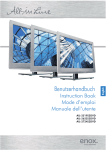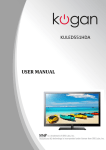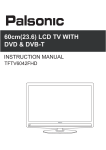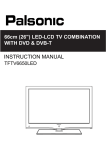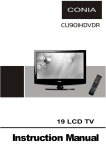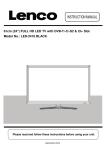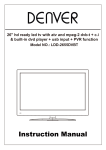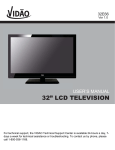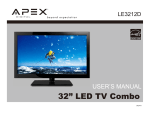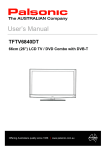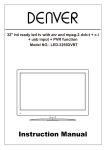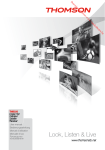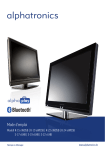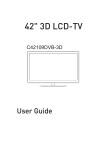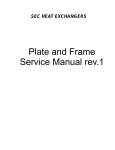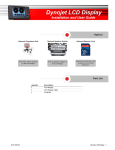Download Remote control
Transcript
55.5cm (22”) Full HD LED TV WITH DVB-S2,H.264,DVB-T/C AND CI Model No.: LED-2217 For information and support, www.lenco.eu Contents SAFETY INFORMATION .............................................................................................................3 Headphone Warning ....................................................................................................................................................... 4 Where to install .............................................................................................................................................................. 4 LED Screen..................................................................................................................................................................... 4 Unit and Accessories ................................................................................................................5 Getting Started.........................................................................................................................5 Front view....................................................................................................................................................................... 5 Remote Control ........................................................................................................................6-7 Aerial connection .....................................................................................................................8 Connecting the TV Antenna ............................................................................................................................................ 8 Connecting external devices ....................................................................................................8 HDMI Lead ...................................................................................................................................................................... 8 SCART Lead.................................................................................................................................................................... 8 VGA Cable ....................................................................................................................................................................... 8 CONNECTIONS ............................................................................................................................................................. 10 PC connection............................................................................................................................................................... 10 VGA, HDMI PC Connection ............................................................................................................................................ 10 Satellite connection...................................................................................................................................................... 10 Connecting an audio system ........................................................................................................................................ 11 Connecting a DVD player .............................................................................................................................................. 11 COAX Connection.......................................................................................................................................................... 12 HDMI Connection.......................................................................................................................................................... 12 SCART Connection........................................................................................................................................................ 12 USB Connection............................................................................................................................................................ 12 AV Connection .............................................................................................................................................................. 13 YPbPr Connection......................................................................................................................................................... 13 Common Interface Slot...........................................................................................................14 USING YOUR COMMON INTERFACE SLOT .................................................................................................................... 14 Auto installation setup ...........................................................................................................14 Power On / Off the LED TV............................................................................................................................................ 14 INSTALLATION MENU OPERATION ..........................................................................................15 INSTALLATION GUIDE .................................................................................................................................................. 15 TV SETTINGS Menu.................................................................................................................16 Auto Scan ..................................................................................................................................................................... 16 PROGRAMME EDIT ....................................................................................................................................................... 18 Signal Information........................................................................................................................................................ 18 Cl Information .............................................................................................................................................................. 18 Dish Setup .................................................................................................................................................................... 18 MENU SETTINGS.....................................................................................................................23 Picture menu................................................................................................................................................................ 23 SOUND menu................................................................................................................................................................ 24 Time menu.................................................................................................................... ........................................... 24 OPTIONS menu............................................................................................................................................................. 24 1 LOCK menu................................................................................................................................................................... 25 Multimedia Operation.............................................................................................................26 Basic Operation ............................................................................................................................................................ 26 1. Photo ........................................................................................................................................................................ 27 2. Music ........................................................................................................................................................................ 27 3. Movie ........................................................................................................................................................................ 28 4. Text ........................................................................................................................................................................... 28 Recording Operation ......................................................................................................................... 29-31 DVD Operation ......................................................................................................................... 32-39 TROUBLE SHOOTING GUIDE ....................................................................................................40 TECHNICAL SPECIFICATIONS .................................................................................................40 cations .......................................................................................................................................................... 40 2 Introduction Thank you for purchasing this LED TV which has been designed and manufactured to give you many years of trouble free service. You may already be familiar with using a similar product but please take time to read these instructions which have been written to ensure you get the very best from your purchase. HDMI terface) is the next generation of digital interface. Unlike conventional connections, it transmits uncompressed digital and audio signals using a single cabl input via the HDMI socket on the back of the TV. Safety is important To ensure your safety and the safety of others, please read the safety precautions BEFORE you operate this product. Disclaimer The illustrations of the LED-TV, accessories and menus shown in this User’s Manual may differ from the actual product. SAFETY INFORMATION IMPORTANT SAFETY INSTRUCTIONS - READ CAREFULLY BEFORE USE. Take note of the following safety information which appears on the back of the TV. CAUTION: TO PREVENT ELECTRICAL SHOCK, DO NOT REMOVE ANY COVER SCREWS, NO USER SERVICEABLE PARTS INSIDE, REFER SERVICING TO QUALIFIED SERVICE PERSONNEL. This symbol indicates that there are important operating maintenance instructions in the literature accompanying this unit. This symbol indicates that dangerous voltage constituting a risk of electric shock is present within this unit. Keep these instructions Do not use this TV near water. Clean only with a slightly damp cloth. Do not block any ventilation openings. Install in accordance with the supplied Quick Start Guide and this User Guide. Protect the power chord from being walked on or pinched, particularly at plugs, and the point where it exits from the TV. Do not allow the power chord to overhang the edge of a table. Unplug this TV during lightening storms or when unused for long periods of time. WARNING! TO REDUCE THE RISK OF FIRE OR ELECTRICAL SHOCK, DO NOT EXPOSE THIS TV TO RAIN OR MOISTURE. THE TV MUST NOT BE EXPOSED TO DRIPPING AND SPLASHING AND NO OBJECTS FILLED WITH LIQUIDS SHOULD BE PLACED ON THE TV. NOTE: No nak candles should be placed on the TV. NOTE: When displaying the same still picture for more than 2 hours without any interruption, the picture contours of the continuously displayed contents may remain visible on screen, i.e. a persistant image remains. The same applies, when displaying for more than 2 hours: the same background/wallpaper logos, video games, computer images, Teletext cont ratio (e.g. 4:3 format) These do not represent any malfunction and will not be covered by the manufacturer’s warranty 3 This unit has been produced according to all current safety regulations. The following safety tips should safeguard users against careless use and the dangers connected with such use. Although this appliance has been carefully manufactured and rigorously checked prior leaving the factory, as with all electrical appliances it is possible for problems to develop. If you notice smoke, an excessive build up of heat or any other unexpected phenomena, you should disconnect the plug from the mains power socket immediately. Ensur y ventilated! Never place next to or underneath curtains! The mains plug or appliance coupler is used as the disconnect device, the disconnect device shall remain readily operable. This set should only be connected to a mains power supply which matches that stated on the label on the rear of the TV - do not attempt to connect it to any other type of supply. The socket - outlet must be installed near the equipment and easily accessible. To prevent overload, don’t share the same mains supply socket with too many other items of equipment. Apparatus with Class 1 construction shall be connected to a mains socket outlet with a protective earth connection. Keep away from rodents. Rodents enjoy biting into el exes. Always hold the plug when pulling out the plug from ex, the the mains supply sock ex can become overloaded and cause a short circuit. Set up the unit so that no one is able to trip over the ex. Do not place heavy it x, which may damage it. Take not ex cannot be reached and pulled by young children, avoiding injury. Do not set up the unit near to heat sources. The casing ex could be damaged by the impact of heat. The screen is made of plastic and can break if damage is done to it. Be careful when collecting sharp edged plastic splinters to avoid injury. Avoid placing the unit on any surfaces that may be subject to vibrations or shocks. To protect the unit during a thunderstorm unplug the AC power cable and disconnect the aerial. Caution: Do not touch the aerial (RF) connector. When you leave your home for long periods of time, unplug the AC power cable for safety reasons. The unit becomes warm when in operation. Do not place any covers or blankets on the unit in order to prevent overheating. The ventilation holes are not to be blocked. Do not set up near radiators. Do not place in direct sunshine. When placing on a shelf leave 5 cm (2”) free space around the whole unit. 4 Do not allow water or moisture to enter the TV. Do NOT use in wet or moist areas such as Bathrooms, steamy kitchens or near swimming pools. Do not use this unit when moisture condensation may occur Any repairs must be c rsonnel only. Do not open this unit. A non-expert attempting to repair the unit could be dangerous and potentially cause re hazard. Liquids spilt into the unit can cause serious damage. Switch the set OFF and disconnect the mains power supply, then c ce person before attempting to use the unit again. Do NOT remove the safety covers. There are no useable or serviceable parts inside. You may invalidate the warranty rsonnel must only service this apparatus. Do NOT tap or shake the screen, you may damage the internal circuits. Take good care of the remote control, do not drop. Never plac rces on or close to the TV. High temperatures can melt plastic and lead t res. To clean the TV use a soft dry cloth. Do NOT use solvents or petr For stubborn stains, you may use a damp cloth with dilute detergent. Headphone Warning Loud music can damage your hearing irreversibly, therefore do not set the volume to a high level when listening through headphones, particularly for lengthy listening periods. Where to install Locate the television away from direct sunlight and strong lights, soft indirect lighting is recommended for comfortable viewing. Use curtains or blinds to prevent direct sunlight falling on the screen. Place the TV on a sturdy platform of which the surfac steady. This will prevent it from falling over. Make sure the television is located in a position where it cannot be pushed or hit by objects, as pressure will break or damage the screen, and so that small objects cannot be inserted into the ventilation slots or openings in the cabinet. LED Screen The LED display panels are manufactured using an extremely high level of precision technology, however sometimes some parts of the screen may be missing picture elements or have luminous spots. This is not a sign of malfunction. Unit and Accessories Getting Started Front view MUTE POWER REC LIST CH/LIST SUBTITLE REPEAT REC DISPLAY TV/AV OK MENU 1 EXIT 2 3 5 6 7 9 0 VOL 4 8 FAV PICTURE EPG SOUND SLEEP INPUT CH SCREEN TV/TXT HOLD CANCEL REVEAL SIZE SUBPAGE MENU NICAM/A2 INDEX CH+ CH- TV set Remote Control Batteries for Remote Control VOL+ VOLPOWER Remote Control window Converter cable for AV and YPbPr video 1). (IR) Infrared Receiver: Receives IR signals from the remote control. (Power on/Standby)LED Indicator: Press POWER to turn on and off. Indicator on(Blue) Indicator on(Off) Standby mode Power on mode The effective receiving range for the signal is 5-8 metres from the front of the remote control window, and 300 to the left or right side and 200 above or below the remote control window. Mains cable Mains adaptor Mains adapter 2).The functions of the buttons are described as bellows: INPUT: Press to display the input source menu. MENU: Press to display the OSD menu, press again to exit the menu. CH+/-: Press to scan through channels. VOL+/-: Press to adjust the volume. POWER: Turn on/standby the TV set. Packaging materials are no toys. Please keep away from children. Plastic bags can cause suffocation when pulled over the head. This Television is designed to work with any DTV Antenna, xed Satellite Dish aligned Analog or Digital cabl with Astr ted with a universal LNB. Other Dishes and LNBs can be used but full set up is required. The Television is preset for the abov xed dish/LNB and when quickstart is used Astra 19.2E will be instantly tuned without need of a “search” 5 Remote control The remote control is using Infra-Red(IR). Point it towards the front of the TV. The remote control may not work correctly if it is operated out of range or out of angle. POWER MUTE REC LIST CH/LIST SUBTITLE REPEAT REC DISPLAY INPUT POWER: Turn the TV on/standby. MUTE: Press to mute the sound, press again or press VOL+ to unmute. REC LIST: Record List. CH/LIST: Display the programs list. SUBTITLE: Turn on/off the subtitle display in DTV mode REP: Repeat playing the title or chapter. REC : Press to start record the program in DTV mode. : Stop program. : Previous chapter. : Next chapter. : Pause program. : Play program. : Fast reverse. : Fast forward. OK MENU EXIT 1 2 3 4 5 6 7 8 9 0 VOL FAV PICTURE EPG SOUND SLEEP CH SCREEN TV/TXT HOLD 6 CANCEL REVEAL SIZE SUBPAGE NICAM/A2 INDEX INPUT: Press to display the input source menu. DISPLAY: Press to display the current mode’s information. MENU: System setup menu. EXIT: Exit the OSD menu. FAV: Display the favorite program list. NUMBER BUTTONS Press0-9 to select a TV channel directly when you are watching TV. Return to the previous channel viewed. CURSOR KEYS OK Allows you to navigate the on-screen menus and adjust the system settings to your preference. Remote control (continued) POWER MUTE REC LIST CH/LIST SUBTITLE REPEAT REC DISPLAY INPUT OK MENU EXIT 1 2 3 4 5 6 7 8 9 0 VOL FAV PICTURE EPG SOUND SLEEP CH SCREEN TV/TXT HOLD CANCEL REVEAL SIZE SUBPAGE NICAM/A2 INDEX CH / : Scan through channels. VOL / : Adjust the volume. PICTURE: Select the picture mode. EPG: To show the Electronic Program Guide during no-menu state only in DTV mode. SOUND: Select the sound mode. SLEEP: Standby timer. SCREEN: Turn on/off the screen. TV/TXT: Turn off/on the Teletext display. CANCEL: Cancel the Teletext display. NICAM/A2: TV Nicam/A2 select. REVEAL: Reveal any hidden text. HOLD: Hold or carry on the current subpage. SIZE: Press to see top half of page double size, Press again to see the bottom half of page double size. Press again for normal size. SUBPAGE: Press to enter subpages, pressagain to cancel. INDEX: Go to index. Colour buttons:Short cuts-follow the coloured links in the text 7 Installing Batteries in the Remote Control Aerial connection 1. Remove the battery compartment cover at the rear of the remote control by pushing the retaining clip forward and pulling up. 2. Install the supplied batteries, ensuring the polarity matches what is shown in the battery compartment. 3. Replace the battery compartment cover. WARNING! ENSURE THE TV AND ALL ANCILLARY EQUIPMENT IS UNPLUGGED FROM THE MAINS BEFORE MAKING ANY CONNECTIONS! Connecting the TV Antenna Connect the TV antenna to the aerial socket with a 75 ohm co-axial plug. For best results use a high gain TV aerial, preferably roof or loft mounted. To improve picture quality in a poor signal area, purchase and inst r. If the antenna needs to be split for two TVs, use a 2Way Signal Splitter (not supplied). Using the Remote Control To use the remote control point it at the TV and press the required buttons. You must be within 6 meters and at an angle of less than 30 degrees from the center of the TV. NOTE: Sunshine or other strong light sources may interfere with the signal from the remote control. In this situation turn the TV away from the light source. WARNING! DO NOT LEAVE BATTERIES IN THE REMOTE CONTROL FOR EXTENDED PERIODS AS THEY CAN LEAK OR CORRODE CAUSING DAMAGE TO THE REMOTE CONTROL. CHECK THEM PERIODICALLY AND REPLACE THEM AS REQUIRED. WARNING! DO NOT MIX BATTERY TYPES. WHEN INSERTING BATTERIES, REPLACE ALL BATTERIES AT THE SAME TIME. DO NOT MIX OLD AND NEW BATTERIES. WARNING! EXHAUSTED BATTERIES MUST BE TREATED WITH CARE AND DISPOSED OF ACCORDING TO ANY SAFETY OR RECYCLING REGULATIONS IN FORCE IN YOUR LOCAL AREA, NEVER DISPOSE OF BATTERIES INTO GENERAL WASTE, OR FIRE. WARNING! NEVER EXPOSE BATTERIES TO EXCESSIVE HEAT SUCH AS SUNSHINE, FIRE OR THE LIKE. Connecting external devices This instruction manual shows the simplest and most effective way of connecting your TV to ancillary equipment. Alternate methods are listed below. HDMI Lead You can connect this TV to a compatible device using a HDMI lead. This method will give the best picture. Connect the cable from the HDMI equipment to the TV HDMI socket. SCART Lead You can connect this TV to a compatible device using a SCART lead. The connection uses component video signals, i.e. the red, green and blue (RGB) content of the video are sent on separate signals. VGA Cable You can use your TV as a monitor for your personal computer by using a VGA cable. Sound from your personal computer may also be played through the TV. 8 Connecting external devices (continued) Output t DVB-S2 Common Int fac Sat t Output t POWER USB HDMI SCART PC-IN VGA MINI YPbPr MINI AV Converter cable audio USB device Satelliten Receiver oder Blue-Ray DVD 9 Connecting external devices (continued) VGA, HDMI PC Connection Name Function Description POWER Connect to power supply HDMI Connect to the HDMI output of your DVD or Satellite Box Use a PC-VGA cable (not supplied) to connect the TV to your PC. You can also use an HDMI cable to connect to your PC (if your PC Graphic card supports HDMI). When the HDMI cable is used, the PC audio cable is no longer required. If you use the HDMI to DVI cable, you will need to use the PC audio cable. Connect all cables carefully and do not bend or break the connector pins. Connect to Satellite signal When using the VGA cable CONNECTIONS DVB-S2 VGA (PC IN) Connect to the PC VGA output to display PC graphics PC-IN PC Audio input Mini YpbPr Connect to the YPbPr output on external devices Mini AV Connect to AV output on external devices SCART Connect to the SCART input / output of external devices RF Connect to TV signal cable Head phone Connect Head phone CI CI slot (Pay as you view card slot) Coax Output t USB Media playback and PVR Switch on the TV Switch on the PC Select PC/VGA as input source When using the HDMI cable Select HDMI as input source VGA cable HDMI to DVI cable Audio cable HDMI to HDMI Caution: Before connecting external devices: Makes sure to disconnect the appliances from the power supply in order to avoid any potential damage from occurring. Make sure to establish the required connection. Make sure that the connectors are properly and correctly attached before connecting the appliances to the power supply. (All illustrated cables are not supplied) Satellite connection DVB-S2 PC connection As PCs are sometimes still supplied with a ‘conventional’ CRT monitor, you may need to adjust the display settings of your PCs graphics card, otherwise the pictures may not appear correctly. Switch on your PC (still with your original monitor connected) now select the screen resolution, and select 60Hz refresh rate. Switch off your PC, then connect it to your TV while both appliances are still switched off. 10 DVB-S/DVB-S2 Signal Connect the DVB-S/DVB-S2 signal to the SATELLITE LNB on the TV SET. Select the SATELLITE input source using the INPUT button on the remote control. Connecting Video camera and Video recorder Connecting an audio system Video camera You can supply the TV sound to the stereo system (A) with the Scart socket. Use a special Scart cable SCART to RCA. (Please consult y structions for details). If you have a surr coder (B) Use the Scart cable or the special Scart cable Scart to RCA. Connect the AV cable to the TV and to the video camera. Turn on both video camera and the TV. Select AV/CVBS source You can now see the playback picture from the video camera. Note: To connect the video camera using other cables, refer to the video camera instruction manual. Video recorder Connect the Scart cable to the TV and video recorder. Turn on both video recorder and the TV. Select Scart source You can now see the playback picture from the video recorder. Note: Scart to RCA cable To connect the video recorder using other cables, refer to the video recorder instruction manual. Scart cable Video recorder (All illustrated cables are not supplied) Scart cable Connecting a DVD player Connect a DVD player using either a SCART cable or the HDMI cable. (only if your external equipment supports HDMI). Use Scart adapter cable HDMI to HDMI Mini Audio and Video transfer cable Video camera (Mini AV cables is supplied) SCART (All illustrated cables are not supplied) When using the SCART cable Switch on the TV Switch on the DVD player Select SCART as input source When using the HDMI cable Select HDMI as input source 11 COAX Connection SCART Connection TV Back DVB-S2 POWER USB HDMI SCART Coax Cable PC-IN Sc D Connect t on the TV. evice to the COAX output jack VGA MINI YPbPr MINI AV cable VCR Back D VCR Connect the SCART connect to the ext tem and the SCART connect V. The SCART lead ope at connection. If the tv does not select the SCART input automatically, select SCART using the SOURCE button on the emote cont v. HDMI Connection TV Back POWER USB HDMI SCART PC-IN VGA MINI YPbPr MINI AV HDMI Cable D VCR Back VCR D HDMI connection allo t ansf ed in digital. to t ansf cont ol signals th ough one cable only. These signals a e USB Connection ve in t lect the USB channel sou ce using the SOURCE button on the emote cont ol. USB P POWER USB HDMI SCART PC-IN VGA MINI YPbPr MINI AV TV Back 12 AV Connection TV Back USB HDMI SCART PC-IN VGA MINI YPbPr MINI AV Audio and video cable (RCA) Mini audio and video transfer cable DVD or VCR back DVD or VCR Connect the VIDEO and AUDIO output jack of the DVD or VCR to the VIDEO jacks on the TV set using the RCA cable. Match the jack colors: Video is yellow, Audio left is white, and Audio right is red. Select the AV input source via the SOURCE button on the remote control. YPbPr Connection TV Back USB HDMI SCART PC-IN VGA MINI YPbPr MINI AV Audio video cable (RCA) Audio cable Mini video transfer cable DVD or VCR back DVD or VCR back DVD or VCR DVD or VCR Connect the YPbPr output of the DVD or VCR to the YPbPr input on the TV set. Connect the Audio output of the DVD or VCR to the Audio input jacks on the TV set using the RCA cable. Match the jacks colors : Y is green, Pb is blue, Pr is red, Audio left is white, and Audio right is red. Select YPbPr input source via the SOURCE button on the remote control. 13 Common Interface Slot Auto installation setup USING YOUR COMMON INTERFACE SLOT Power On / Off the LED TV Common Interface To turn on the LED TV The Common Interface (CI) slot is designed to accept the Conditional Access Module (CAM) and Smart Card in order to view the pay TV programmes and additional services. Contact your Pay Per View TV service provider to get more information about the modules and subscriptions. Press the power button on the LED TV or the POWER button on the remote control, the standby indicator will light green. NOTE: Conditional Access Module and Smart Cards are sold separately. WARNING! SWITCH OFF YOUR TV BEFORE ANY MODULE IS INSERTED INTO THE COMMON INTERFACE SLOT, THEN ADD THE SMART CARD TO THE CAM. CI Slot CAM Smart Card 1. Turn on the TV and ensure ‘DTV’ Source is selected. 2. If the CAM is detected the TV will display the following message on the screen. “Common Interface Module inserted” wait for a few moments until the card is activated. 3. Select the relevant digital Pay Per View channel. 4. Detailed information on the Smart Card in use is displayed 5. Press the Ok button to access the card menu. Refer to the Module Instruction Manual for setting details. 6. When the module is removed, the following message will appear on the screen. “Common Interface module removed”. 14 INSTALLATION MENU OPERATION DTV will install a Digital Terrestrial Television service (DVBT) INSTALLATION GUIDE When powering up f Will appear on screen. Choose the language using OK ATV will install an Analogue Television cable service rst time the Installation Guide During the channel search this menu is displayed showing the progress. buttons and then press Choose the service to install using the then press ok. buttons and You will now see the quick-start menu. Ensure that your signal cable is connected to the TV and press OK 2 times. The TV will now install the chosen service and tune all available channels. You can only install one service at a time but you can return at any time to install additional services by pressing the QUICKSTART button on the handset 15 TV SETTINGS Menu SATELLITE / DISH SETTINGS Input Source DTV CADTV SATELLITE ATV SCART YPbPr PC HDMI AV USB DIGITAL CABLE (DVBC) SETTINGS All the above installations can also be accessed through the Main Menu system. In the TV Settings menu. To access the correct service you need the TV to be in the correct mode, ATV, DTV, cable or Satellite. Select the mode either from the handset or from the source menu. When you are in the correct mode, press Menu button on the remote control and enter the TV Settings Menu Press MENU button to display the main menu, use left/right buttons to select EINSTELLUNGEN menu, press OK or down button to enter the menu. Press MENU or up button to return to the main menu. Auto Scan In the Auto Scan menu there are 3 options for you to select from: DVB Select type, Country and Tune Type. NOTE: TV SETTINGS can only be selected under the ATV/ DTV/SATELLITE/CABLE modes, it is disabled whilst in all other modes. ATV / CABLE SETTINGS / to select DVB Select type, Country and Tune Press Type, press OK to start scanning. DTV / DVB-T SETTINGS rst 50% of the processing is If you select ATV+D for ATV tuning, while the second 50% represent DTV tuning. When ATV tuning, you can press MENU to Skip ATV tuning and start DTV tuning or press EXIT to exit tuning. During the channel search this menu is displayed showing the progress. 16 Unlike QUICKSTART the satellite search will search the whole satellite for channels and will not be instant. You can manually tune CADTV channels in the TV SETTINGS menu. Also the channels will appear in the order on the satellite and not the pre-set order. Frequency Select Frequency using the buttons. Symbol (ks/s) Select the Symbol (ks/s) using the buttons. QAM Type Select the QAM Type using the buttons ATV Manual Tuning You can manually tune ATV channels in the TV SETTINGS menu. Auto search replaces any previous searched channels with those of the new search. To add an extra satellite if you have a suitable Dish/LNB/Switch you must use the Dish Installation menu. DTV Manual Tuning Storage to Press the buttons to change the numbered location of the found channel. System Select the system using the buttons. Current CH You can manually tune DTV channels in the TV SETTINGS menu. Press the Left/Right arrow buttons to select the channel you wish to tune, then press OK button to scan for the channel. CADTV Manual Tuning Displays the current channel number, press the buttons to choose the channel you wish to modify. Search Press the buttons to scan through the frequencies to ew channels. Fine tune In case of bad reception, you can press the buttons to mak stments to the tuning. After manual tuning is complete, please press the RED button to save any found channels. 17 PROGRAMME EDIT Dish Setup Use up/down keys to select program edit. Press OK or Right button to enter the menu. Use up/down buttons to navigate through the menu 1. If you do not hav xed dish aligned to Astra 19.2E ted with universal LNB you will need to use this section. ed Dish aligned to a different Satellite 2. If you hav or with a different LNB you will need to use this section. 3. If you have a motorised Dish with a DiSEqC rotator and wish to tune more than one satellite you will need this section. 4. If you are on a DiSEqC switch system you will need this section. rst 2 installations can be done by most people so long as you know what satellite your dish is aligned with ted with. Delete Press the RED button to delete the highlighted channel, a red circle will appear next to the channel name. Press the RED button again to c lete. Press the MENU to return to the main menu. Installation of 3 & 4 require an experienced user or engineer. To set a different Satellite or LNB Select Satellite mode, press MENU key, navigate down to the Dish Setup option, press OK. You will see the Satellite Dish Setup menu. Move Press to select the channel, press yellow button to enter the move mode, then press to move the channel location, press yellow button again or press OK to c Press MENU to return to the main menu. Skip Press to select the channel you wish to skip. Press the BLUE button, a logo will appear next to the channel name and the channel will be skipped when you scroll through the channels. Press the BLUE button again on the highlighted channel to disable the skip function. Press MENU to return to the main menu. Rename (Only available in ATV) Modify current channel name. Press the button to enter RENAME mode, then use buttons to change name. Press green button the again or press menu button to c FAV Select a program, press FAV button to set or delete the program as the favorite channel. Signal Information Only available in DTV mode, Signal Information includes: channel /network/modulation/quality /strength. Cl Information When insert CI Module, display CI Information. 18 To set Multiple Satellites and LNBs (only possible on multi-LNB dish, switch systems) Use buttons to select the satellite to which your dish is aligned. Press OK. An arrow will display against the chosen satellite. Press button to navigate to LNB section of the menu. Select the LNB type and settings for your LNB. Press the blue Key to search the satellite channels. Press the Exit button and the ond satellite. button to select the sec- buttons to select the second satellite to which Use your dish is aligned. Press OK. An arrow will display against the chosen satellite. Press button to navigate to LNB section of the menu. Select the LNB type and settings for your second LNB and switch settings. Press the blue Key to search the satellite channels. A full description of the advanced Dish set up for multiple satellites using DiSEqC switches and DiSEqC positioner follows. This should only be attempted by experience users. The Dish set up main menu page displays the main interface. The interface consists of Satellite List, Transponder list and Dish/LNB parameter list Input Frame (On-screen keyboard) Satellite Edit Longitude Direction: Added to determine the location of the satellite. Use the arrow buttons to select West/ East. Press the Green button to enter the edit menu Edit parameters as described below Longitude Angle: Input Longitude. By moving the cursor buttons to enter the satellite longitude. No. The current list number of the selected satellite Satellite name. Edited from the onscreen keyboard press button to enter. Band: band selection. Press to select. Delete Satellite menu Press the YELLOW button, the c pear. Press OK to delete. - Add Satellite Satellite List Press the RED button to see the Add menu. The Satellite list displays the satellite names. In the input frame, use characters. NO: This is the list placing number. This number cannot be manually edited. and OK button to select Extend: Extended characters Caps On: Change character case. Press OK button to select. Back: Delete letters, press OK to c OK: Sure to set the naming of the satellite, and return to Edit Menu Cancel: Return directly back to edit menu. 19 Transponder List Add Transponder The list shows the transponders for the selected satellite. Press RED button to enter the add transponder menu. No. Can not be manually edited. Frequency: Set the downlink frequency. Symbol (ks/s): Set the Symbol Rate. Polarity: (H/V) Dish Parameter description LNB Type: LNB Frequency Edit Transponder menu Press GREEN button to enter Transponder edit menu. No. This is the list placing number. Nr. cannot be manually edited Frequency: Set the downlink frequency. Symbol (ks/s): Set the Symbol Rate. Polarity: (H/V ) Delete Transponder Press the YELLOW button, the c pear. Press OK to delete. 20 - Highlight the LNB Type , and use the to enter submenu then you c buttons and Ok rameters. KHz: The level of the LO switch / DS switch ( Require the user to have installed 22KHzSatellite signal switch). to select Auto/On/Off. Press Auto: Automatically issued 22 KHz pulse signal to control switching. On/Off: Manual control switch. Tone burst: Double Single Switch (Require users to install Tone burst switch), Press to select Burst A/Burst B/None. Burst A /Burst B: Manually switch the satellite A/B. DiSEqC1.0.4: select 1 switch ( Require the user device support DiSEqC 1.0 protocol). Press to select LNB1/ LNB2/ LNB3/LNB4/None. LNB1/LNB2/LNB3/LNB4: Corresponding to a satellite , After selecting the corresponding list will appear in the satellite list. LNB Power: Polarization switching power supply, Press to select On/Off. DiSEqC 1.1: 16 select 1 switch ( Require the user device support DiSEqC1 .0 protocol) Equipment needs support DiSEqC 1.1 protocol, Most control 16 LNB. Press to select LNB1~LBN16/None. LNB 1-LNB 16: Corresponding to a satellite, After selecting the corresponding list will appear in the satellite list. Motor: Control of multi-satellite polar (Require the user device support DiSEqC1.2 or DiSEqC1.3 protocol), Left and right buttons to select DisEqC1.2/ DisEqC1.3/None. DisEqC1.2: DisEqC1.2 Protocol selection DisEqC1.3: DisEqC1.3 Protocol selection For Mot te “DisEqC1.2” , Operating Instructions: Press RED button to enter “Set Limit" menu. Press OK button to enter Set Position menu. On: Allowed to receive Horizontal / Vertical Polarization program. Off: out-off of supply. 21 Press RED button to enter “Set Limit” and Mot as “DiSEqC1.3” “Set Limit’ menu same. Move Continue: Control of the east or the west continued to turn the polar axis to the desired position. Move Step: Control of the east or wes axis step rotation. xed polar Set West Limit: The current position is set to the maximum point of the west. Press GREEN button to enter Set Location menu. Set East Limit: The current position is set to the maximum point of the east. Goto Reference: Back to the default values. Disable Limit: Abolish the current limit set. Location: Select the user area or similar areas, if the user is not in the system default settings when in these areas, can select Manual custom settings. Longitude Direction: Select the user area in the east longitude or longitude. Longitude Angle: Longitude angle. Select the user area in which the longitude, Enter the appropriate values to move the cursor. Move Auto: East or west of Automatic Control continued to turn the polar axis to the desired position. Latitude Direction: Select the user area in the latitude or latitude. Move Continue: Manual control of the east or the west continued to turn the polar axis to the desired position. Latitude Angle: Select the user latitude area, Enter the appropriate values to move the cursor. Move Step: Control of the east or wes axis step rotation. Press OK button to enter Set Position menu. xed polar Store Position: Save the current rotation angle of polar axis. Goto Position: Control the polar angle automatically to the previously saved. Goto Reference: Control the angle of polar axis automatically to the default. When Mot te “DisEqC1.3”. 22 Move Auto: East or west of Automatic Control continued to turn the polar axis to the desired position. MENU SETTINGS Move Continue: Manual control of the east or the west continued to turn the polar axis to the desired position. Picture menu Move Step: Control of the east or wes axis step rotation. xed polar Store Position: Save the current rotation angle of polar axis. Goto Position: Control the polar angle automatically to the previously saved. Goto Reference: Control the angle of polar axis automatically to the default. GotoX: Area based on user input parameters, Automatically calculate the satellite over the area, Control the polar axis rotation to the right place. Scan Menu When all the parameters after. Press BLUE button to Tuning the setup menu to enter. Picture Mode: Choose from Standard, Dynamic, User and Mild. Note: Contrast, Brightness, Colour and sharpness are only available and can be adjusted in the User mode option in the Picture Mode Settings. Contrast: Controls the difference between the brightest and darkest regions of the picture. Brightness: Controls the overall brightness of the picture. Colour: Control the colour. Sharpness: Increase this setting to see crisp edges in the picture; decrease it for soft edges. Tint: Controls the tint ( NTSC mode only). Scan Mode: Scan from Default, Blind Scan and Network to select. Colour Temperature: Choose from Medium, Cool, User and Warm. Default: Default search program. Red: Controls the red colour of the picture. Blind Scan: Searches all the programs for the LNB settings. (This is a long sear including new Channels). Green: Controls the green colour of the picture. Network: Search the known channel frequencies for the selected LNB & Satellite settings at the time of manufacture. (This will be the quickest search) Aspect Ratio: Choose from , 4:3, 16:9, Zoom1, Zoom2, and Panorama. Channel Type: FTA (Free to Air) or ALL (Free to Air and Pay Channels) Blue: Controls the blue colour of the picture. Noise Reduction: Choose interference noise modes from Off, Low, Middle, High and Default. Service Type: DTV (DVB TV) or Radio (DVB Radio) or both DTV & Radio Polarization: Polarization of the LNB (Low noise Block), (H) Horizontal or (V) Vertical Or Auto (according to the settings in the LNB set-up pane.)Menu Settings 23 SOUND menu On Time: Press OK button to enter the submenu, you could set the time when the TV set will be turned on automatically, you could also set the frequency, volume and program. Sleep Timer: Allows you to setup the sleep timer among: 10min, 20min, 30min, 60min, 90min, 120min,180min, 240min and off. Auto Sleep: Turn on/off the auto standby function. Time Zone: Allows you to select the time zone. OPTIONS menu Sound Mode: Allows you to select among: Standard, Music, Movie, Sports and User. Treble (Can be adjusted when the sound mode is set to User): Controls the relative intensity of higher pitched sounds. Bass (Can be adjusted when the sound mode is set to User): Controls the relative intensity of lower pitched sounds. Balance: To adjust the balance of the left and right speakers audio output, or turn off the volume of the left or right speaker. Auto Volume: This feature automatically adjusts the audio level when the TV is turned on. This function is activated by selecting “On”. Surround Sound: Turn on / off the surround sound function by selecting “off” or “on” SPDIF MODE: Allows you to select among: Off, PCM and Auto. TIME menu OSD Language: Allows you to select the on screen display menu language. Audio Language (can only be selected in DTV mode): Select the audio language. Subtitle Language (can only be selected in DTV mode): Select the subtitle language. Menu Time Out: Allows you to setup the length of time that the on screen display is visible: 5s, 10s, 15s, 20s, 25s, 30s, 35s, 40s. Country: This is defaulted to Germany, but can be changed by using the Auto tune function. Restore Setting: Press the OK button to restore the factory default settings. Clock: Use the and use the and and buttons to select the position, buttons to set the time. Note: User can not change time manually during DTV mode, for time is from signal source directly. Off Time: Press OK button to enter the submenu, you could set the time when the TV set will be turned off automatically, you could also set the frequency. 24 LOCK menu The password must be entered to access the Lock Menu. The default password is 0000. Once inside the menu you can change the password to your own choice. Channel lock is used to block selected Channels Parental Guidance blocks programmes according to their parental level. 25 7.Hotel Mode Input Source DTV CADTV SATELLITE ATV SCART YPbPr PC HDMI AV USB 26 Multimedia Operation Basic Operation 1). Press the INPUT button on the remote control to display the input source menu, select USB source by the / buttons, and press OK button to enter the Multimedia menu seen below. Input Source DTV CADTV SATELLITE ATV SCART YPbPr PC HDMI AV USB Select 2). Insert USB device, you will find the name of the device display on the screen. MAINS MENU PHOTO MUSIC MOVIE TEXT USB device list Disk C: MAINS MENU PHOTO MUSIC MOVIE TEXT Select Hints for operation Hints and informations of USB device 3). Press / button to select the kind of the files in the device you want to program from PHOTO, MUSIC, MOVIE and TEXT. Press / button to select the device and press OK button to enter. Return to device list Up Folder Preview Informations Press / / / buttons to move , and press OK button to select the file or unfold the folder, Then press button to program the files (be signed) you select or the files in the fold you select, You can display the option table on the bottom of the screen by OK button, press button to hide. Press button to stop and exit the full screen program. 27 Multimedia Operation 1. Photo Play the photo Press / button to select the option on the table, and press OK button to change. Repeat: Select the repeat mode from Repeat All, Repeat 1, Repeat None. Music: Play/pause the music program (you can only play or pause the music you have programed). Playlist: Display the playlist on the screen, and you can select the photo by / button, and press OK button to program. Press / button to return to the options table. Info: Display the information of the photo. Rotate: Rotate the photo clockwise/counterclockwise. Zoom Out/In: Zoom out/in the photo. Move View: Move the photo in Zoom out mode. 2. Music Play the music Press Press / / button to select the option on the table, and press OK button to change. button to select the music, and press OK button to program. Repeat: Select the repeat mode from Repeat All, Repeat 1, Repeat None. Goto Time: Program the music form the time you set. Press OK button to display the time table, and select the position by / / / button, set the time by the number buttons, select “OK” and press OK button to search. Screen Saver: Press BLUE button to enter the Screen Saver mode, press again to exit. 28 Multimedia Operation 3. Movie Play the movie GOTO Time Press / button to select the option on the table, and press OK button to change. Repeat: Select the repeat mode from Repeat All, Repeat 1, Repeat None. Set A-B: Select and play the preferable paragraph of the program by seting A and B at the beginning and end, and there will be a sign on the left screen, press OK button again to cancel. Playlist: Display the playlist on the screen. Info: Display the information of the movie. Slow: Play the programs at slow speed, press button to cancel. Step: Step the programs by OK button, press button to cancel. Goto Time: Program the movie form the time you set. Zoom out/in: Zoom out/in the movie screen. Aspect Ratio: Select the aspect ratio of the screen display. Move View: Move the photo in Zoom out mode. 4. Text Play the text Press / button to select the option on the table, and press OK button to change. Prev/Next page: Turn to previous/next page of the text. Prev./Next: Turn to previous/next file. Stop: Stop auto turning pages. Music: Play/pause the music program. Playlist: Display the playlist on the screen. Info: Display the information of the text. 29 Recording Operation PVR settings Press the MENU button, and select CHANNEL menu. Recording Timer 1). Recorded List Display the recorded list Recorded list: Display the Recorder List menu, and changed the mode of program. INFO: Display the information of the program you recorded. RED button: Delete the program you select. 2). Recording Timer Set the recording timer The TV will record the program automatically according to your settings. TITLE: Display the name of the recording program. MODE: Select the record mode. Start Time: Select the start recording time. End Time: Select the end recording time. Press OK button to save the setting and exit the menu. 30 Recording Operation 3). Schedule List Display the recorder shedule Note: a. Could’t add shedules which have existent on the list; b. Could’t add shedules when the list is full, you have to delete some schedules; c. You could delete a schedules by RED button on the remote control. 4). PVR File System Setup the PVR File system before you start recording. Select Disk: Select the device for the Record files. Check PVR File System USB Disk: Display the USB state. Format: Format the USB device for PVR operating. Time Shift Size: Display the size of the USB device (The device has been formated). Speed: Display the speed of the USB device (The device has been formated). 31 Recording Operation 5) Record Start When you finish the settings above, you could start recording by select Start Recording in the menu and press OK button in DTV and DVBS mode. (You can also start recording by press the on the remote control) Record buttons Recording: Press to enter the recording mode. PAUSE: Press to enter the timeshift mode. Recording list: Press to display the recording list. Stop: Press to stop recording. Recording menu When you press REC button, the screen will display the recording menu as below: Full mode Simple mode Note: a. You could change the mode of Recording menu by REC/Exit button. b. Press STOP button to exit the recording mode. c. Press PLAY button to play the program you are recording from the beginning. d. Press Recording list button to display the Recorder list, and you could play the program you selected. The recording will be going on, and the Recording menu will display when you exit the Recorder list. Timeshift Press PAUSE button to enter the Timeshift mode, and the picture will be paused, the recording will begin. Note: a. You could change the mode of Timeshift menu by REC/Exit button. b. Press STOP button to exit the Timeshift mode. c. Press PLAY button to play the program you are recording from the beginning. Playback The current state of the program The current time The process of the program A-B mark The name and number of the program 32 button TROUBLE SHOOTING GUIDE To assist in locating possible faults use the help guide below. SYMPTOM SOLUTION No Picture, no sound Check that the TV is correctly plugged in. Check that the TV is connected to a suitable power source. Check the electrical supply is turned on. No Picture Ensure that the TV is powered on. Check that the cables ar ted securely. Ensure the aerial and/or external sources are connected. Press the SOURCE button to change the source. Turn the TV on or off. No Sound Press the MUTE button and check if Mute mode is set. Switch to another channel and see if the same problem occurs. Press V+ button to see if the problem can be solved. No picture on some channels Check that correct channel is selected. Adjust the antenna. No colour on some channels (black &white) Check if the same problem exists on other channels. Ensure the correct picture settings are selected. Noisy, Snowy, Ghosting picture. Check the antenna is connected correctly. Check that the antenna Is in good condition. Try moving the antenna. If none of the suggestions seem to work, try switching your TV off and then on again. If this does not work contact our technical helpline. NOTE: The TV must only be repair registered service person. Never attempt to remove the back cover as the TV has dangerous voltages inside that may cause fat re. TECHNICAL SPECIFICATIONS cations of the TV that you have just purchased may vary from the information in this table due to technical innovations. cations TV System SECAM/BG/DK/L/L’ Audio System BG/DK/I/L/L’ Screen size 21.6(Diagonal) Resolution 1920 x 1080 Pixel(RGB) Aerial input 75 Ohm (unbalanced) Audio output power 2 x 3W Power requirements 12V Power consumption 3.33A 40W Standby power consumption <0.5W Weight 4.2/4.9Kg Remote contr cations Type Infrared Control distance 5m Control angle 30 degrees (Horizontal) Batteries 2 x 1.5V, Size AAA Dimensions 48 x 193 x20mm Weight 120g (without batteries) 33 I LENCO II LED-2217 27 55,5 39 22




































